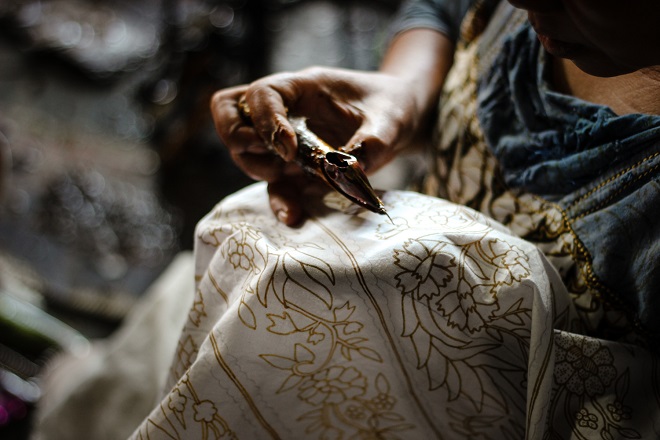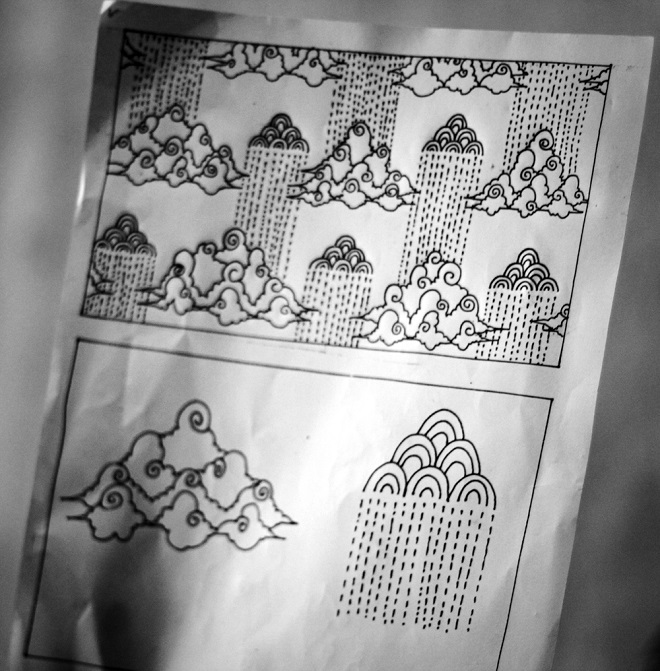Indonesian Craft :: Riding with Rafheoo (Part 1)
In the first of three articles, Frank Sedlar delves into the materials and handiwork that goes into the bags of Rafheoo, a young company based in Jakarta, Indonesia crafting bags which draw upon the rich Indonesian artistic traditions.
My taxi weaves through the infinite procession of motorbikes. The first call to prayer lingers in the morning air. I gradually drift off to sleep in the pre-dawn traffic of Jakarta, heading to my rendezvous. Moments later, I’m jolted awake by the rap of a flashlight against the taxi’s window, held by a gruff-looking officer. Not even 5 am and we’re already being shaken down. The customary 50,000 Rupiah ($4) exchanges hands, the officer wryly thanks us, and we’re back on the road, now pushing to catch the 5:30 am train to Central Java.
Rolling out of the taxi I’m greeted by my companions for this excursion. I’ve been invited by the guys behind the Jakarta-based bag manufacturer Rafheoo to join them as they source the materials for a new bag from some of the top artisans the island of Java has to offer. On the agenda are textiles, batik, buckles, and leather. And judging by the bags these guys are touting, they’re onto something.

The first thing that strikes you about the Rafheoo crew is their age. A few years ago these four friends Hendi Dermawan Putra, Agra Geneosya, Alif Pratama, and Ramadanu still in high school were making the most of Indonesia’s 17,000+ islands through frequent travel. Though the scenery left an impression, the bags they were using certainly did not. Hendi, the fast-talking frontman of the group, takes care of the introductions and the five of us quickly start talking shop. Sharply dressed with an eye to the American workwear aesthetic, for being only a few years out of high school these guys are an impressively discerning bunch when it comes to carryology.
While still in high school the Rafheoo crew and a whole other group of young Indonesians were religiously reading the online forum darahkubiru.com (literally, ‘my blood is blue’) covering all things denim. This denim passion soon spread into boots, leather goods and finally bags. Emerging from this scene and motivated by a desire to make a bag that worked for their travels the four of them formed Rafheoo in 2011. Two years later they opened their own workshop in Jakarta. Working amidst the collective Indonesian handcrafted tradition it was then only a matter of time before Rafheoo began seeking out artisans for the components of their bags. It’s these artisans, most of whom also grew up on darahkubiru.com, that have made for a very full trip itinerary.

As our train speeds through the rice fields of Central Java framed by the characteristically tropical blue sky, I’m filled in on the details of the Indonesian bag industry. On the whole it’s a very young industry with bags that would catch the eye of a Carryologist not appearing on the scene until 2009. As the industry experiences the inevitable growing pains, Hendi is frank that for the time being they will not be on the industrial or technical level of the much lauded Japanese manufacturers. Though perhaps it is for the better. As Hendi points out this strengthens the Indonesian conviction that, “if there is no machine, I can make it with my hands.”
To demonstrate exactly what they mean by this, the Rafheoo crew has decided to craft a new bag highlighting the craftsmanship, skill, and art found across Indonesia. Staying true to the conviction, everything that goes into this bag, including the assembly, will be done by hand. And since simply having the finished materials delivered to them in Jakarta would take the meaning out of the finished product, we’re off to pay a visit to these workshops.

The train gradually rumbles to a stop in Pekalongan on the north coast of Java. Pekalongan is known as the ‘City of Batik,’ the now UNESCO certified traditional textiles made by using wax to dye the fabric. With numerous Batik manufacturers in Pekalongan, the city’s river changes color depending on that day’s Batik order.

The man we’re here to meet is Asfa Fuadi, the face behind Lumintu Mills. Humble in his demeanor and always wearing a gentle smile that conceals the brilliance of this textile virtuoso, his talent is nevertheless apparent in the exquisite attire he is wearing, all designed and created with his own hands. Though only a few years older than the Rafheoo crew, textiles are in Asfa’s blood. Following in the footsteps of his father and grandfather (who the Indonesian government paid to travel the world studying textiles) Asfa studied textile engineering in college, promptly returning to Pekalongan with the goal of promoting and innovating within the ancient textile tradition of his city.

Stepping into the workshop of Lumintu Mills, brimming with equipment, it quickly becomes apparent that Asfa is making good on these goals. Lining one wall are 15 antique Japanese shuttle looms meticulously worked over by 15 pairs of hands producing weaves. The only electricity in the entire building is for the radio, powering its static drawls.


The opposite side of the room handles the back end of preparing raw cotton for its pass on the shuttle looms – everything from dying to warping. It’s difficult to comprehend the precision of each movement in this workshop. The image of the shuttle looms, where thousands of threads are individually threaded not once but twice, gives way to the thump – thump – thump – THUMP as the looms methodically beat out every yard of fabric, at most 15 yards/day.


As bag makers, such a manual operation opens up a world of opportunities for Rafheoo (it’s worth noting that the craftsmen in Lumintu Mills earn more than civil servants in Pekalongan). Color, pattern, thickness, stiffness, and numerous other options make the textile of Rafheoo’s bags highly inventive, specific and always distinct.


From Lumintu Mills with yards of freshly milled fabric in tow we head across town to the workshop of Pak Erlando to begin the traditional batik process. This process is old. Real old. Well over one thousand years old. Batik itself is a technique of applying wax onto cloth, dying the fabric, washing off the wax, and then repeating. The results are simply stunning and as I’ve come to expect from these guys, they’ve got a distinctly Rafheoo pattern in the works for this bag.

Pak Erlando’s batik workshop is a sprawling area, quite the opposite of the tight lines and exact dots gracing every bit of fabric in the workshop. In the center of the room a small group of women sit around a pot of melted wax, dipping their cantings into the pot and then delicately guiding the flow of wax through the spouted opening onto the fabric. Out back the men dip the cloth in large pots of colored dye, leave the fabric to dry and then wash the layer of wax off in a pot of boiling water. And that’s just for one color. It’s a long process but the results speak for themselves.

The idea for the batik pattern that the Rafheoo crew designed for this bag came from one of their many travels through Java. In a scene fitting of a Hollywood movie they found themselves atop a mountain near the city of Bogor in a field of edelweiss flowers gazing at rainclouds in the distance. Back in Jakarta a buddy of theirs, Idham Hudayah, sketched the concept which we’re now watching transformed into a batik pattern.




Observe their inspiration gradually take shape in the form of hot wax which is deposited onto some of the finest textiles in Indonesia and you get an idea of the creative process behind Rafheoo, and the work that goes into each bag, and the homage paid to Indonesian artistic traditions – and we’re only halfway through sourcing the materials for this bag. With the smell of hot wax in our noses, the sound of weaving wooden mills in our ears, batik patterns in our eyes, and bags on our minds (think the Carryology version of The Night Before Christmas) we board a night bus bound for the center of Javanese artistry, Yogyakarta.

*Follow Frank’s adventures on Instagram!





 Carry Awards
Carry Awards Insights
Insights Liking
Liking Projects
Projects Interviews
Interviews















